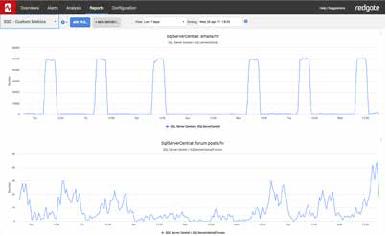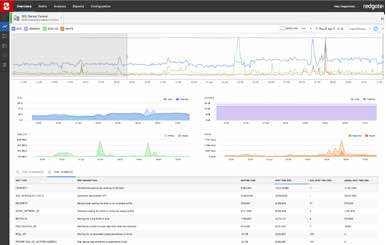Metrics install automatically if you have Redgate Monitor installed.
If you are using Redgate’s SQL Server monitoring tool, Redgate Monitor, you can instantly install and run this metric on your servers.
This metric measures the number of tables without clustered indexes defined that contain more than 1000 rows per database. It is good practice to define the clustered index for every table in the database to help improve query performance.
Note: Having a clustered index per table is NOT compulsory. There are cases, where a heap (table without a clustered index) is acceptable.
To analyze further, the following query can be used to find out which indexes don’t have clustered indexes defined:
[sql]WITH CTE_1
AS
(
SELECT db_name() as dbname,
o.name as tablename,
(SELECT SUM(p.rows)
FROM sys.partitions p
WHERE p.index_id = i.index_id
AND i.object_id = p.object_id) as number_of_rows
FROM sys.indexes i
INNER JOIN sys.objects o
ON i.object_id = o.object_id
WHERE OBJECTPROPERTY(o.object_id, ‘IsUserTable’) = 1
AND OBJECTPROPERTY(o.object_id, ‘TableHasClustIndex’) = 0
)
SELECT *
FROM CTE_1
WHERE number_of_rows > 1000;[/sql]
Metric definition
Name
Tables without clustered indexes defined
Description
This metric measures the number of tables without clustered indexes defined that contain more than 1000 rows per database. It is good practice to define the clustered index for every table in the database to help improve query performance.
Note: Having a clustered index per table is NOT compulsory. There are cases, where a heap (table without a clustered index) is acceptable.
To analyze further, the following query can be used to find out which indexes don't have clustered indexes defined:
WITH CTE_1
AS
(
SELECT db_name() as dbname,
o.name as tablename,
(SELECT SUM(p.rows)
FROM sys.partitions p
WHERE p.index_id = i.index_id
AND i.object_id = p.object_id) as number_of_rows
FROM sys.indexes i
INNER JOIN sys.objects o
ON i.object_id = o.object_id
WHERE OBJECTPROPERTY(o.object_id, 'IsUserTable') = 1
AND OBJECTPROPERTY(o.object_id, 'TableHasClustIndex') = 0
)
SELECT *
FROM CTE_1
WHERE number_of_rows > 1000;
The T-SQL query that will collect data
Instances to collect from
Select all
Databases to collect from
1
Collection frequency
86400
Use collected or calculated values
Leave the Use a calculated rate of change between collections check box unchecked
Metric collection
Enabled
Alert definition
Alert name
Tables without clustered indexes
Description
This alert is raised when the number of tables without clustered indexes defined that contain more than 1000 rows per database exceeds set thresholds. It is good practice to define the clustered index for every table in the database to help improve query performance.
Note: Having a clustered index per table is NOT compulsory. There are cases, where a heap (table without a clustered index) is acceptable.
To analyze further, the following query can be used to find out which indexes don't have clustered indexes defined:
WITH CTE_1
AS
(
SELECT db_name() as dbname,
o.name as tablename,
(SELECT SUM(p.rows)
FROM sys.partitions p
WHERE p.index_id = i.index_id
AND i.object_id = p.object_id) as number_of_rows
FROM sys.indexes i
INNER JOIN sys.objects o
ON i.object_id = o.object_id
WHERE OBJECTPROPERTY(o.object_id, 'IsUserTable') = 1
AND OBJECTPROPERTY(o.object_id, 'TableHasClustIndex') = 0
)
SELECT *
FROM CTE_1
WHERE number_of_rows > 1000; Raise an alert when the metric value goes
Above the defined threshholds
Default threshold values
| High: | 500 |
| Medium: | 100 |
| Low: | 0 |
Note: These thresholds are intended as guideline values. If they seem too high or too low for your environment, replace them with values more suited to your server performance.
Raise an alert when the threshold is passed for
1 collection
Alert is
Enabled
 12,482
12,482 
